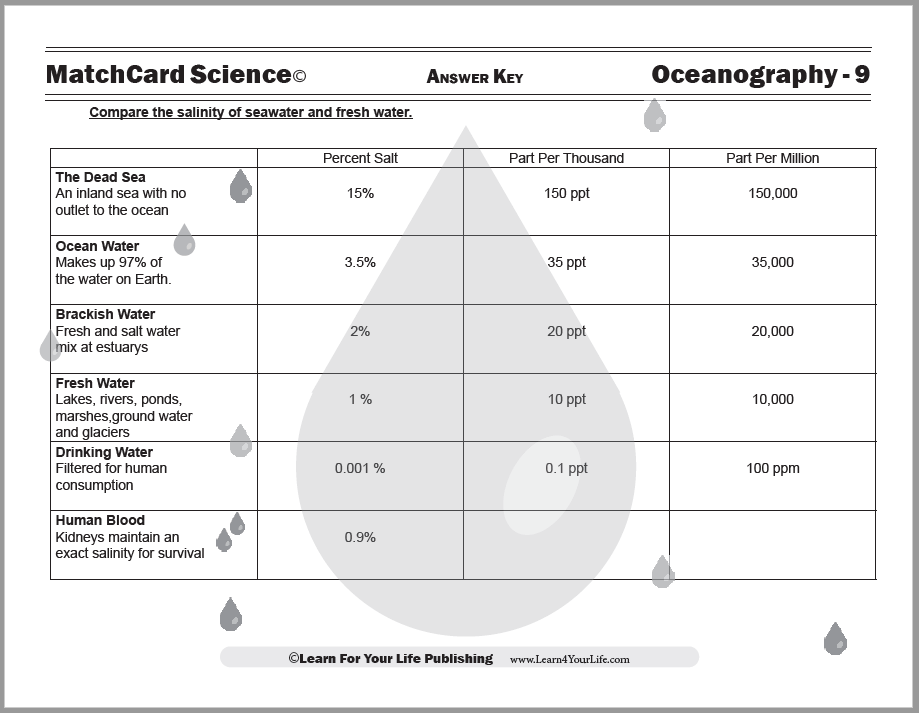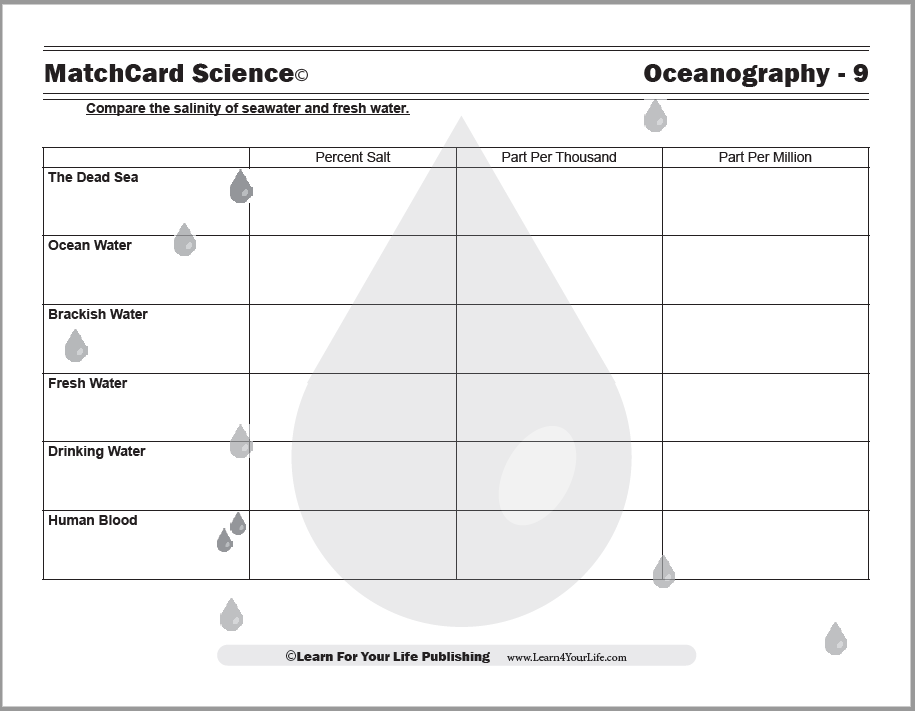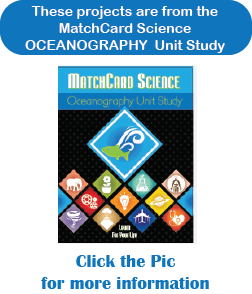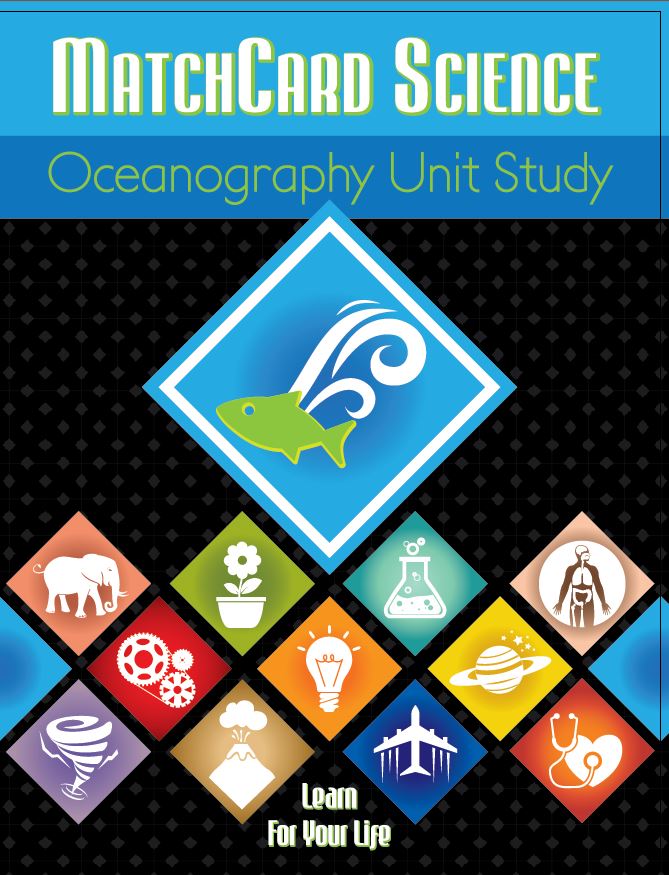Freshwater vs Saltwater
How Salty is the Water?
We know sea water is salty, but did you know freshwater also has salt? Human blood does too. Kids investigate the salinity of different liquids with this Science MatchCard and fun hands-on projects.
Answer Key

Free Download Below
Student Page


Saltwater MatchCard
Activities: Watch it float, Objective: Compare the salinity of seawater and fresh water.MatchCard: Download below.
A quick breakdown of some salty information:
- Dead Sea 15% salinity
- Ocean Water 3.5%
- Fresh Water 1.0%
- Human Blood 0.9%
Print the Salinity MatchCard
This is MatchCard #9 of the Oceanography Unit Study. More information on the MatchCard Science curriculum is at the bottom of this page.Hands-Learning: Sink or Float
Here’s a famous demonstration that shows the difference in specific gravity between salt and fresh water. You will need- 2 transparent glasses filled with 1 cup water
- 2 tablespoons of salt
- 2 eggs
- Ice
- Food coloring
The egg floated in the salt water because the density of the salt water (mass divided by volume) is greater than the density of the egg. Learn about density>
Would you float higher in salt water or fresh water? (Answer: You have greater bouyancy in the salt water and will float more readily.)
Continue with the activity below.
Salt, Ice, and Food Coloring
After doing the demonstration above, take the eggs out of the glasses.Add ice to both glasses. Then add food coloring and watch how the salt effects the distribution of dye.
Freezing Temeprature of Salt Water
If you are lucky enough to get a hold of salt from the ocean for this experiment: great. Otherwise, you can substitute with regular tapwater and salted water as you did in the demonstration earlier. With this experiment we ask if the salt will change the freezing temperature of water.- 2 non-glass containers (Used water bottles with lids work great. Other suggestions are included in the unit study.)
- 2 tablespoons of salt
- Thermometer
- Put one cup of water in each container.
- Add salt to one container.
- Put into the freezer.
- Check the temperature and the percentage of water that is frozen every 20 minutes.
- What is your conclusion? Did the salt water take longer, shorter, or the same length of time to freeze?
Salinity of Different Sources of Water
In the unit study students brain-stormed all the sources of water they could think of. Now let's learn more about those different sources of water.Ocean Water - 97%
We cannot drink the salt water in the ocean. If you just took a little tiny drop from the glasses in the demonstrations you just did, you would quickly agree that salt water is not drinkable. Although sailors at sea are surrounded by water, they cannot drink it. Ships must carry their own supply of drinking water.Polar Ice - 2%
Snow and Ice make up much of our non-ocean water. The polar ice and glaciers have LOTS of water in its solid form.Ground Water - 0.75%
Ground water is the water beneath the surface of the ground. The water that falls on your yard will find its way to local streams. But before it does it seeps through the ground, and makes its way into geological cracks and crevices.From there it heads towards the nearest source of flowing water.
Surface Water - 0.24%
Only 1/4 of 1% of water is left. Most of this is in the ponds, rivers, marshes, and lakes. These sources are collectively called surface water. They comprise about 0.24% (or 0.0024) of Earth’s water.Why are these called surface water? Compared to the ocean, the water in the deepest lakes and river are still superficial.
Fraction of a Fraction
We only have 1% of 1% left of Earth's water unaccounted for. Approximately 0.0001 of all water is left. We can divide this into:- Atmosphere 0.00009 (0.009%)
- Biological Water 0.00001 (0.001%)
Pie Chart
Make a pie chart to show the sources of Earth's water. A paper plate with ridges is a great aid for pie-chart-making.More Activities
Our oceanograhy unit study will provide you with more activities for salinity, including learning about math and fractions.It also includes 8 other great lessons on Earth's awesome oceans.
MatchCard Science
How To Use MatchCards

Download the FREE MatchCard Science Instructor's Guide and see how MatchCards can make building their science knowledge base fun.
Ocean Unit Study

12 Science Unit Studies

Chemistry is only one of twelve complete unit studies for kids in 3rd to 8th grade.
Comprehensive objectives, hands-on projects, suggested science fair experiments, and the fun game-like MatchCards keep them interested in learning science. See all twelve MatchCard Science Unit Studies.
About Our Site
Hands-On Learning














